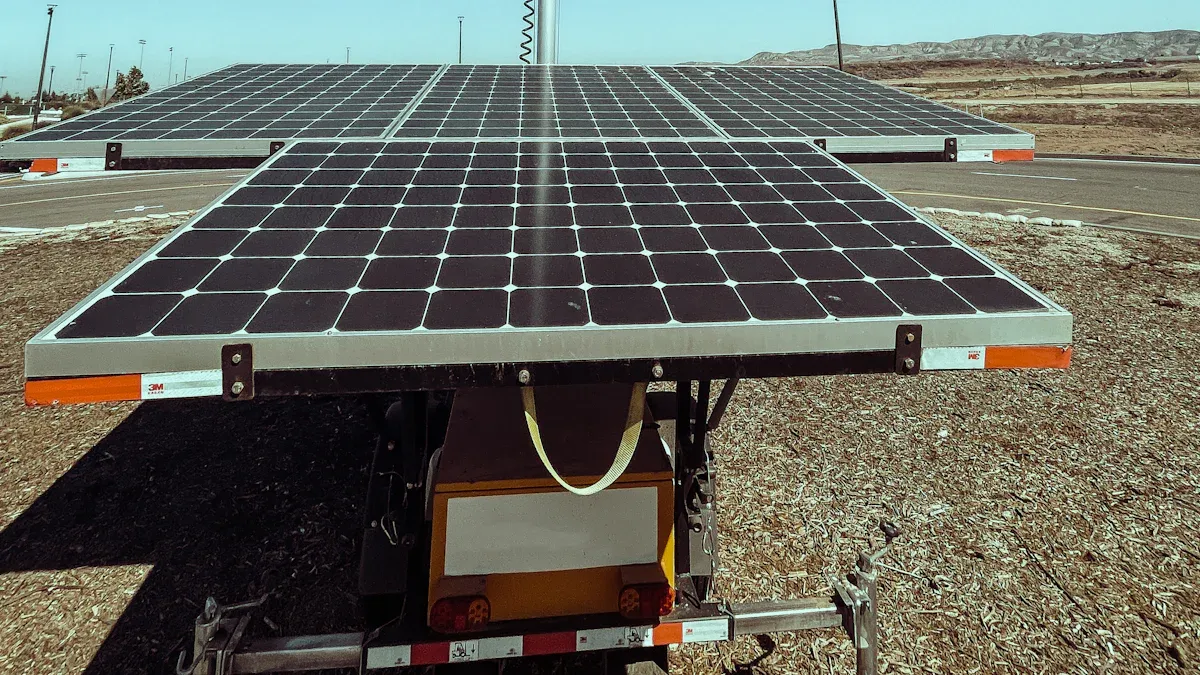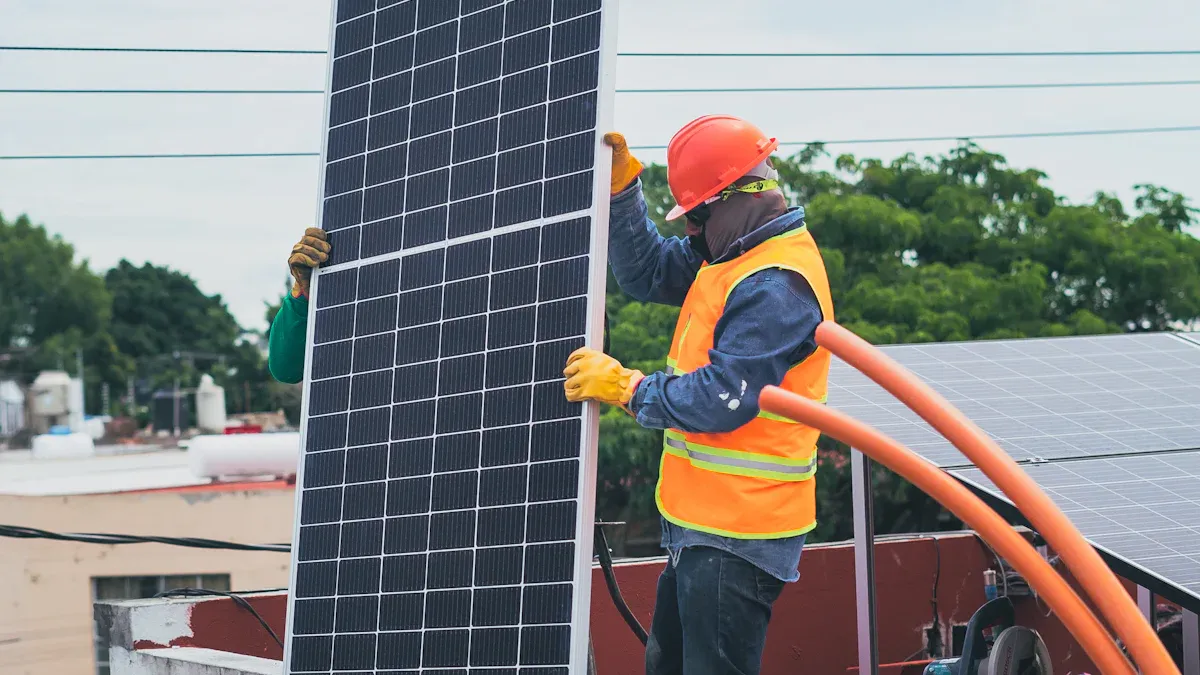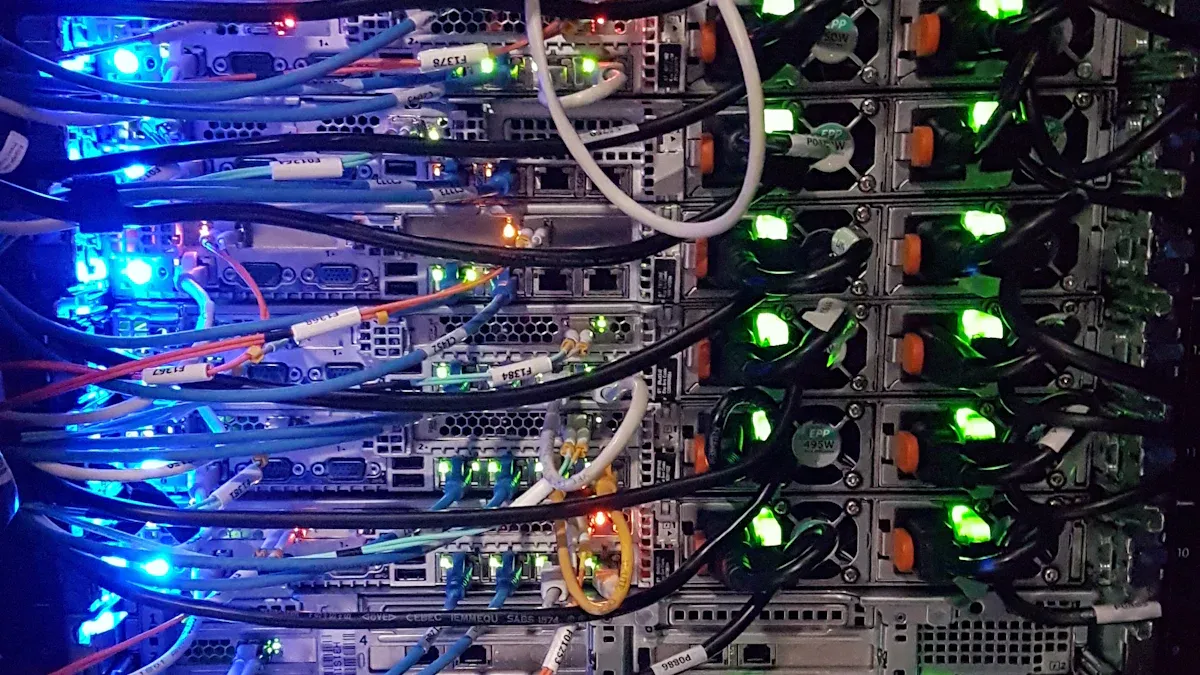Understanding PV Panels for ESTEL Telecom Cabinet Applications

A pv panel transforms sunlight into usable energy, making it a critical component for powering telecom cabinet infrastructure. In ESTEL telecom cabinet applications, solar panels deliver consistent renewable energy, supporting the essential operation of telecom towers and power cabinet equipment. Reliable solar power reduces downtime, increases operational continuity, and supports sustainable telecommunication networks. The table below highlights how solar solutions enhance cabinet reliability compared to traditional power sources:
Aspect / Feature | Impact on ESTEL Telecom Cabinet Reliability |
|---|---|
Mechanical Reliability | Panels have no moving parts, reducing failures in remote telecom cabinet locations. |
Mean Time to Failure (MTTF) | Solar systems offer higher MTTF for power cabinet longevity. |
Failure Rate (λ) | Lower failure rate keeps telecom cabinet operations stable. |
Availability | High availability ensures telecom towers and power cabinet systems stay active. |
Downtime Reduction | Solar power solutions cut downtime by 25%. |
Renewable solar energy, combined with advanced monitoring and hybrid power cabinet solutions, ensures that telecom cabinet operations remain efficient and environmentally responsible. These applications of telecom solar power systems demonstrate the value of integrating renewable panels into modern telecom cabinet infrastructure.
Key Takeaways
Solar PV panels provide reliable, renewable energy that improves telecom cabinet uptime and reduces downtime by 25%.
Advanced battery storage and smart management systems ensure continuous power supply even during night or cloudy weather.
Proper installation, safety compliance, and regular maintenance keep solar-powered telecom cabinets efficient and long-lasting.
Hybrid power systems combining solar, batteries, and grid or generators increase reliability and lower operational costs.
Using solar power in telecom reduces carbon emissions, supports sustainability, and cuts fuel expenses by up to 68%.
PV Panel Basics

What Is a PV Panel
A pv panel serves as a device that captures solar energy and converts it into electrical power. In telecom applications, these panels play a vital role in delivering reliable energy to telecom cabinets. Each pv panel consists of several main components that work together to ensure efficient energy generation:
Solar PV Modules: These modules contain many semiconductor solar cells. The cells absorb sunlight and convert it into electrical energy through the photovoltaic effect.
Module Junction Box: This box provides safe, weatherproof electrical connections and output terminals, allowing the generated energy to flow safely to telecom equipment.
Module Mounting Structure: The mounting structure secures the panels in place, ensuring they face the sun for maximum energy capture and withstand harsh outdoor conditions.
Toughened Glass and Aluminum Frame: The glass protects the cells from environmental damage, while the frame offers structural support.
Encapsulation Layers and Back-sheet: These layers shield the cells from moisture and mechanical harm, increasing the lifespan of the pv panel.
Recent advancements in pv panel technology have improved efficiency and durability. New materials like perovskite and multi-junction cells boost conversion rates, providing more energy for telecom cabinets. Weatherproof designs and eco-friendly manufacturing also support long-term sustainability for telecom infrastructure.
How PV Panels Generate Energy
Solar panels generate energy by using the photovoltaic effect. When sunlight hits the silicon cells inside the panel, it excites electrons, creating direct current (DC) electricity. This energy then travels through the junction box and wiring to power telecom cabinets. Inverters may convert DC to alternating current (AC) if needed for certain telecom equipment.
Environmental factors can affect how much energy the panels produce. High humidity can cause condensation and corrosion, which may damage both the pv panel and telecom cabinet. High temperatures can reduce efficiency and shorten the lifespan of the panels. To address these challenges, telecom cabinets often use corrosion-resistant materials and active cooling systems, such as fans or air conditioning, to maintain stable internal conditions.
Note: Proper thermal management and humidity control help maintain energy output and protect sensitive telecom equipment. Smart monitoring systems can detect faults early, reducing downtime and ensuring continuous power supply.
Solar Power for Telecom Cabinets
Solar Energy Conversion
Solar power for telecom towers begins with the conversion of sunlight into electrical energy. Modern solar panels use silicon-based solar cells, which have seen significant improvements in efficiency over the past decades. In the 1980s, panel efficiency was below 10%. Today, standard modules reach nearly 25%, while specialized cells can achieve up to 50%. This leap in efficiency ensures that telecom solar power systems deliver reliable energy for power cabinet operations, even in challenging environments.
The process starts when solar panels capture sunlight. The photovoltaic effect occurs as photons from sunlight strike the silicon semiconductor material. This action excites electrons, causing them to move and generate direct current (DC) electricity. The generated DC energy flows into the power cabinet, where it powers telecom equipment or charges batteries for later use. Inverters may convert DC to alternating current (AC) if the telecom system requires it.
Key steps in the conversion process include:
Solar panels absorb sunlight using silicon-based solar cells.
The photovoltaic effect generates DC electricity.
Inverters convert DC to AC when necessary.
Battery storage systems store excess energy for use during periods of low sunlight.
Mounting systems position panels for optimal sunlight exposure.
Monitoring systems track energy production and system health.
Solar-powered telecom towers rely on this efficient conversion to maintain continuous operation. High energy efficiency reduces the need for backup generators and lowers operational costs. Hybrid power systems often combine solar with other energy sources, such as wind or grid power, to further enhance reliability.
Note: The photovoltaic effect forms the foundation of solar energy conversion. This process enables telecom solar power systems to provide stable, renewable energy for off-grid telecom towers and hybrid power cabinet installations.
Battery Storage and Management
Battery storage plays a crucial role in solar power for telecom towers. These systems store excess energy generated during peak sunlight hours, ensuring that telecom cabinets receive uninterrupted power even at night or during cloudy weather. Reliable battery storage is essential for off-grid telecom towers and hybrid power systems, where downtime is unacceptable.
Battery management systems monitor energy flow, battery levels, and power consumption. They use intelligent power management units to prioritize solar energy, switch to grid or battery storage as needed, and activate backup generators only when necessary. This approach maximizes energy efficiency and extends battery lifespan.
Common battery chemistries used in telecom solar power systems include:
Battery Chemistry | Key Characteristics | Typical Use in Telecom Solar Power Storage | Lifespan / Cycle Life Notes |
|---|---|---|---|
Lithium Manganese Oxide (LMO) | Fast charging, high current discharge | Short backup times in UPS | Longer life with NMC mix |
Lithium Nickel Manganese Cobalt Oxide (NMC) | High specific energy, versatile | Mission critical UPS, grid-interactive storage | Lifespan varies by use |
Lithium Iron Phosphate (LFP) | Cost-effective, safe, long-lasting | Common in telecom energy storage | High cycle life, safer |
Lithium Nickel Cobalt Aluminum Oxide (NCA) | High energy, stable | Less common in UPS | Long design life |
Lithium Titanate (LTO) | Fast charging, very safe | Safety and long life priority | Extended lifespan |
Lithium Iron Phosphate (LFP) batteries stand out for their safety, cost-effectiveness, and long operational life. These batteries tolerate full charge cycles and have a high thermal runaway threshold, making them ideal for telecom solar power systems in remote or harsh environments.
Battery systems store excess energy for continuous power supply.
Lithium-ion batteries offer high efficiency and long life.
Lead-acid batteries provide a cost-effective option but with lower efficiency.
Battery capacity must match the load demands of the power cabinet.
Remote monitoring tracks energy generation, battery status, and power usage.
Smart load management prevents energy waste and optimizes performance.
Advanced MPPT technology supports stable and efficient power delivery.
MPPT (Maximum Power Point Tracking) controllers act as the heart of telecom solar power systems. They regulate voltage, prevent battery overcharging, and protect against deep discharging. MPPT controllers also stop reverse current flow at night, which prevents energy loss. These features extend battery life and ensure reliable operation for telecom towers and power cabinet systems.
Tip: Remote monitoring and diagnostics allow for real-time visibility and proactive maintenance, reducing the risk of equipment failure in off-grid telecom towers.
Standard Voltage for Telecom
Standard voltage plays a vital role in the safe and reliable operation of telecom solar power systems. Regional voltage standards differ: North America uses 120V/60Hz AC, Europe uses 230V/50Hz, Japan uses 100V (with either 50Hz or 60Hz), and China uses 220V/50Hz. Manufacturers design telecom power supplies with universal input voltage ranges and automatic frequency adjustments to accommodate these differences.
Standardization ensures safety by meeting international standards such as UL 62368-1 and IEC 62368-1.
It reduces risks like electrical shock and fire in telecom cabinet installations.
Standard voltage enhances the reliability and compatibility of power cabinet systems across regions.
It facilitates global market access and compliance with environmental regulations, such as RoHS.
Telecom solar power systems must meet these voltage standards to ensure safe and efficient operation. Hybrid power systems often integrate solar, grid, and generator sources, requiring careful voltage management. Consistent voltage regulation protects sensitive telecom equipment and maintains high system performance.
Note: Standardized voltage and safety compliance are essential for the global deployment of solar-powered telecom towers and hybrid power cabinet systems.
Integration with ESTEL Telecom Cabinets

System Components
ESTEL telecom cabinets use a combination of advanced components to support solar and hybrid power systems. Each cabinet includes solar panels, charge controllers, battery banks, inverters, and monitoring units. The power cabinet manages energy flow between the solar source, batteries, and telecom equipment. Hybrid systems often combine solar with grid or generator power to ensure continuous operation. Mounting structures secure solar panels and protect them from harsh weather. Smart monitoring systems track energy output and detect faults, helping technicians maintain reliable telecom service. The integration of these components allows the cabinet to deliver stable power for telecom towers, even in remote locations.
Installation Steps
Installing solar panels for cell towers in ESTEL telecom cabinet systems follows a structured process to ensure optimal performance and safety:
Site selection and preparation come first. Technicians choose locations with maximum sunlight and minimal shading. They consider weather conditions and ensure easy access for maintenance.
Equipment checks follow. Teams inspect solar panels, battery banks, and controllers for damage or defects. They verify that all components meet system specifications.
Regulatory compliance is essential. Installers obtain permits and follow local standards, such as BIS IS 16270:2023 and MNRE efficiency requirements.
Mounting solar panels for cell towers involves positioning panels facing true south with the correct tilt angle. Proper mounting prevents shading and allows for easy cleaning.
Electrical connections and safety measures include installing ground-fault protection, arc-fault interrupters, and grounding according to IEEE and IEC standards.
Initial system testing checks for durability and performance. Tests include thermal cycling, humidity freeze, and hot spot detection.
Regular cleaning and inspection maintain efficiency. Technicians clean panels every six months and check for loose wiring or damage.
Ongoing monitoring and maintenance use smart tools to track energy output and system health. Scheduled tasks include battery inspection and inverter testing.
These steps ensure that the power cabinet and hybrid systems deliver reliable power to telecom equipment.
Safety and Compliance
Safety and compliance play a critical role in installing solar panels for cell towers and integrating them with telecom cabinets. The following table summarizes key enclosure ratings:
Rating Type | Description | Protection Level |
|---|---|---|
NEMA 3 | Protects against rain and dust | Suitable for outdoor use |
NEMA 4X | Adds rust protection | Ideal for harsh environments |
NEMA 12 | Protects against dust and water | Suitable for indoor applications |
IP ratings, such as IP66, provide additional protection against dust and water, which is vital for outdoor telecom cabinets.
Risk assessment and control measures identify hazards like electrical faults or fire risks.
Design verification ensures safety features work under real-world conditions.
Safety testing covers dielectric strength, temperature, and electromagnetic compatibility.
Certifications like UL and CE confirm compliance with international standards.
Post-market surveillance maintains ongoing safety throughout the product lifecycle.
International standards, including IEC 61508, UL 508, IEC 62368, and ISO 14971, guide the design and operation of hybrid power cabinet systems.
Proper component ratings, insulation distances, and thermal management help meet these standards.
Tip: Following these safety and compliance guidelines protects telecom equipment, ensures reliable power delivery, and extends the lifespan of solar and hybrid systems in every power cabinet.
Benefits and Challenges of Solar Power
Reliability and Uptime
Telecom solar power systems deliver strong reliability for telecom towers and cabinet operations. These systems reduce dependence on unstable grids by generating electricity daily. Battery storage ensures continuous power during outages, preventing network downtime. In regions where grid power is unreliable, such as areas where over 60% of towers lose power for more than eight hours each day, solar solutions maintain steady operation. Diesel generators can provide instant power, but they often face outages and require frequent maintenance. A hybrid solar system test in Mali demonstrated 100% network uptime over six months, showing that solar-powered telecom cabinets can achieve continuous operation. Advanced monitoring software tracks performance and detects issues early, further improving reliability.
Cost and Energy Savings
Switching to telecom solar power systems brings significant cost savings for telecom operators. Solar solutions can reduce fuel costs by up to 68% compared to diesel generators. Hybrid systems cut generator use by over 90%, saving thousands of dollars annually. Operational costs drop by nearly half when using solar PV instead of diesel. Solar systems also eliminate fuel delivery logistics and provide stable, predictable energy costs. Payback periods for PV panel investments in telecom towers range from three to six years, with faster returns in areas with high fuel prices or frequent outages. Despite higher initial costs, the long lifespan and low maintenance of solar panels make them a cost-effective renewable energy solution.
Maintenance Needs
Telecom solar power systems require regular maintenance to ensure optimal performance. The most common tasks include inspecting for physical damage, tightening bolts, checking structural stability, and monitoring for corrosion. Cleaning panels is essential, especially in dusty environments. In some regions, cleaning every two weeks is necessary, while in cleaner areas, twice a year may suffice. Annual professional inspections help maintain system reliability. Remote monitoring tools allow operators to schedule maintenance proactively, reducing downtime and costly repairs. Proper installation and compliance with safety standards also support long-term system efficiency.
Environmental Impact
The environmental benefits of telecom solar power systems are substantial. Solar PV hybrid systems can reduce CO2 emissions by about 55%, with even greater reductions expected as 5G networks expand. For example, one telecom operator achieved an annual reduction of 3,750 tons of carbon emissions by switching to solar panels. Lifecycle assessments show that PV panels have much lower greenhouse gas emissions than fossil fuel power sources. While manufacturing and disposal create some emissions, these are minor compared to the operational emissions of diesel generators. PV systems offer a cleaner, more sustainable power source for telecom towers and cabinets, supporting global sustainability goals and reducing the environmental footprint of telecom infrastructure.
PV panels provide reliable, renewable energy for telecom infrastructure, especially in ESTEL telecom cabinets. These systems improve uptime, reduce costs, and support sustainability. Telecom operators should consider using low-power, high-efficiency RF components, corrosion-resistant materials, and modular equipment. They can also benefit from advanced solar cell and battery technologies, robust enclosures, and hybrid energy setups. Telecom networks in rural areas gain resilience and efficiency with solar-powered solutions. For tailored telecom cabinet integration, operators should consult ESTEL’s experts.
Use low-power, high-efficiency RF components for better telecom energy efficiency.
Employ corrosion-resistant materials to protect telecom equipment.
Design modular telecom systems for easy deployment.
Optimize RF filters to improve telecom signal clarity.
Utilize advanced solar and battery technology for reliable telecom power.
Build robust telecom enclosures for harsh environments.
Adapt telecom systems for hybrid energy sources.
Extend telecom battery life with optimized RF systems.
Enhance rural telecom connectivity with solar-powered solutions.
FAQ
What are the main benefits of using solar power for telecom towers?
Solar power for telecom towers offers reliable energy, reduces operational costs, and supports sustainability. These systems lower carbon emissions and provide renewable energy solutions for off-grid telecom towers. Operators see improved uptime and fewer maintenance needs compared to traditional power sources.
How does a pv panel improve energy efficiency in telecom applications?
A pv panel converts sunlight into electricity with high efficiency. Telecom solar power systems use this energy to power cabinet equipment. Improved energy efficiency means less wasted power and better performance for telecommunication networks, especially in remote or hybrid installations.
What is involved in installing solar panels for cell towers?
Installing solar panels for cell towers includes site selection, equipment checks, and regulatory compliance. Technicians mount panels, connect them to the power cabinet, and test system performance. Proper installation ensures reliable energy supply and maximizes the benefits of renewable energy solutions.
Are hybrid power systems better for telecom cabinet applications?
Hybrid power systems combine solar, batteries, and sometimes grid or generator power. These systems increase reliability and performance for telecom cabinets. Hybrid solutions ensure continuous power, even during cloudy days or at night, making them ideal for critical telecommunication infrastructure.
What are the environmental benefits of telecom solar power systems?
Telecom solar power systems reduce greenhouse gas emissions and reliance on fossil fuels. These systems support sustainability by providing renewable energy for telecom towers and cabinets. Operators help protect the environment while maintaining high system performance and energy efficiency.
See Also
A Comprehensive Guide To ESTEL Outdoor Telecom Cabinet Design
Solar Energy Storage Solutions Designed For Telecom Cabinets
Exploring The Power System Behind ESTEL Telecom Cabinets
Simplified Steps For Installing ESTEL Outdoor Telecom Cabinets
Telecom Cabinets Powered By Grid-Connected Solar Inverter Systems
CALL US DIRECTLY
86-13752765943
3A-8, SHUIWAN 1979 SQUARE (PHASE II), NO.111, TAIZI ROAD,SHUIWAN COMMUNITY, ZHAOSHANG STREET, NANSHAN DISTRICT, SHENZHEN, GUANGDONG, CHINA


